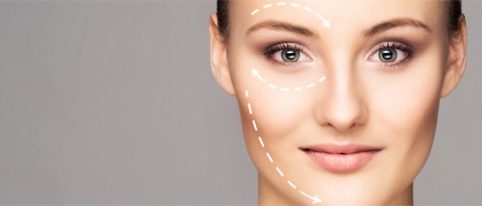
What role does collagen play in your skin and how can you boost this powerful ingredient?
You’ll be very familiar with it, may well own skincare which aims to boost it, but do you know the role collagen plays in the body and how you can actually enhance your own supply? Collagen is vital to ensure the strength, elasticity, hydration and cell renewal capability of our skin. It is is naturally produced by our bodies and is our most abundant protein, found in our muscles, bones, skin and tendons. What is it precisely and how can we increase its production? Dr Saira answers your queries.
What is the role of collagen in the skin?
Collagen is the most abundant structural protein in the dermal layer and provides the skin with its mechanical and tensile strength and, along with elastin fibres, it also influences the skin’s elasticity and resilience to environmental stress.
Collagen also acts as a supporting network for other essential components such as hyaluronic acid which acts to retain moisture in the skin. In early life, prior to the onset of visible skin ageing, our collagen fibres are plentiful and tightly interwoven in an organised matrix of bundles which contribute to the appearance of smooth, plump, wrinkle-free skin.
From what age does collagen degrade naturally?
Our skin’s collagen is in a process of constant self-renewal and generally from the mid 20’s to the mid 30’s collagen levels remain relatively stable as our collagen stimulation is adequate to balance the effects of collagen loss. It is after the age of 40 onwards that there is a significant shift in this process and it results in a net loss of collagen at a rate of 1% per year which in turn results in a loss of dermal thickness of about 6% per decade. This is known as “chronological ageing” – a basic biological process which is genetically programmed. The process of collagen loss is amplified in women following menopause due to a lack of oestrogen.
What speeds up this breakdown?
1. Sun exposure is the biggest accelerator of collagen degradation and associated premature ageing of the skin. Mature collagen loss or disruption related to chronic sun damage is characterised by deep wrinkles, laxity issues and textural problems of the skin. It is important to highlight the profoundly damaging effect of tanning beds on the skin due to the intensity of UV light used. As well as damaging our collagen, the use of tanning beds is a significant risk factor for skin malignancies.
2. Smoking also contributes to premature skin ageing and is probably due to increased DNA damage resulting in a reduction of new collagen synthesis. In particular, early wrinkling around the mouth or “smokers lines” are more commonly seen in those who smoke tobacco.
3. Pollution is another common environmental aggressor that induces a chemical reaction in the skin called oxidative stress which generates toxic molecules called free radicals which damage skin cells and collagen fibres, accelerating the process of intrinsic skin ageing.
4. Glycation. High sugar loads in the body are damaging to skin’s collagen due to the process of glycation where sugar molecules bind to your collagen fibres rendering them functionally ineffective.
What are the obvious signs/symptoms of collagen loss?
Facial ageing is multifactorial as bony remodelling, volume loss, impaired skin quality and gravitational effects all contribute. However the progressive loss of collagen from the dermis is a key player in what we see as the visible signs of ageing, hence why collagen stimulation treatments are so popular. Collagen loss manifests as thinning of the skin, deep wrinkles, crepe-like texture and sagging of the skin.
Are there some areas of the face/skin that are most susceptible, or does loss occur evenly across the face?
The eye contour zone, the décolletage and the skin on the back of the hands are vulnerable areas which are more susceptible to collagen loss and premature ageing. This is because the dermal layer of the skin is thinner in these areas and has a lower proportion of collagen compared to other facial zones. There is also less supporting fatty tissue in these areas and are therefore more susceptible to volume loss and textural problems.
It is my understanding that the main way that treatments such as ultrasound (Ultherapy), radiofrequency (Intracell) plus dermarolling work is by micro injuries to the cells to stimulate the fibroblast to make more collagen. Do you agree with this?
These treatments all work to induce collagen production. This is achieved by controlled micro injury of the skin to trigger a “wound healing” response, which is manipulated for the purpose of rejuvenation. Fibroblasts are stimulated in response to inflammatory mediators, and produce new collagen to repair the “damaged” tissue. The process of collagen remodelling continues for some time after the initial injury and is responsible for the improvement of tone, texture and elasticity of the skin following treatment.
What is your preference of treatments which work the best?
- Energy based treatments such as laser skin resurfacing or radiofrequency fractional skin resurfacing to stimulate collagen and rejuvenate the skin surface by targeting the signs of sun damage.
- Medical microneedling such as dermaroller are great for those with scarring or more advanced textural issues including enlarged pores
- Medium to deep chemical peels are excellent for softening fine lines and wrinkles as well as improving the appearance of hyperpigmentation or “sun spots” commonly associated with chronic sun damage.
- Silhouette Soft threads for a dual lift and collagen regenerating effect in selected patients
Also importantly, how frequently do you need to have these treatments done for optimal results?
In general, for optimal results it is ideal to start with an intensive course of treatments whether it be radiofrequency fractional skin resurfacing or a chemical peel. Initially treatments should be performed every 4-6 weeks to augment the natural skin cycle. Anywhere between 3 and 6 treatments may be indicated depending on the extent of collagen loss and visible sun damage. Following an initial course, maintenance treatments are recommended to boost ongoing collagen stimulation and skin remodelling every 6 months or so.
What would you prescribe (skincare wise) to aid collagen production?
Topical vitamin C and retinoic acid are essential components of an anti-ageing skin care regime. They act synergistically to accelerate the cell renewal process, exfoliate the skin and stimulate new collagen formation.
What sort of patients would you select to treat with a Silhouette Soft thread lift?
The ideal candidate for a Silhouette Soft thread lift is male or female, between the age of 40 and 65, with mild to moderate collagen loss and skin laxity issues. The skin quality should be optimised with combination therapies such as medical grade skin care and skin resurfacing techniques in order to achieve the best results. On assessing a patient, the skin laxity issue should be easily corrected using gentle pressure with a finger to lift the tissue against gravity by 1 cm to its ideal position.
To talk to Dr Saira about collagen or any other questions concerning your skin, contact us on 020 7489 3846 or email info@waterhouseyoung.com.
Popular articles
Eat your way to healthier skin
The latest on radiofrequency microneedling technology
How to improve skin elasticity - The ultimate guide to getting your bounce back
Relevant topics
More topics
- Acne
- Ageing Skin – Face
- Botox
- Collagen
- Congested Skin
- Cooltherapy Fat Reduction
- Cosmetic Acupuncture
- Dark Circles
- Dehydrated Skin
- Dermal Fillers
- Dermaroller
- Dry Skin
- Eczema
- EndyMed Pro 3DEEP
- Excess Fat
- Excessive / Unwanted Hair
- HealGel
- Heliocare
- Holiday Skin
- HydraFacial
- HydraHeal
- Intraceutical Infusion
- Laser Hair Removal
- Lines & Wrinkles
- Lip Volume
- Loose Skin – Body
- Male Grooming
- Menopause
- Microneedling
- Obagi
- Oily Skin
- Psoriasis
- Quick Reads
- Recommended Products
- Redness
- Rosacea
- Silhouette Soft
- Skin Nutrition
- Skincare
- Skincare Regime
- Skinceuticals
- Sleep
- Soprano ICE
- Sun Damage
- Teeth Grinding
- VI Peel
- Wellbeing
- Wrinkle Treatments
- WY Exclusive
- WY Tips




